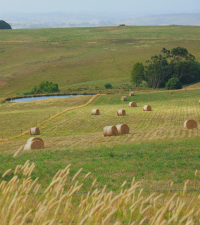Can Regenerative Agriculture Feed a Growing Global Population?
January 28, 2022

The following is a guest piece written by Paul Greive and Meredith Cochran from Pasturebird.
Regenerative agriculture has tried to solve the issues and utter depletion that factory farming has caused. While we know that regenerative agriculture can play a role in feeding a growing global population, we still desperately need large-scale solutions that not only work but that work for us. We also desperately need transparency in raising practices so consumers can become more connected to the food that they eat. While national chicken consumption continues to grow exponentially and the demand for it pushes some into practices that focus less on quality and more on quantity, Pasturebird has chosen another route that completely changes how chickens can (and should) be raised.
A disruption in animal agriculture is required if regenerative agriculture can continue to play a role in the solution to the crisis of a depleted planet.
In order to give chickens their best life, they need the ability to live on fresh pasture 24/7, and that requires shelter. This shelter provides the chickens with protection from both the weather and potential predators that’s also mobile so it can move daily to fresh grass. This allows us to utilize rotational grazing, a fundamental philosophy within regenerative agriculture that’s critical for the overall health of land and soil. Typically, these shelters are small and require time and human labor to move daily, which can diminish economies of scale for producers.
Enter the ARC (or Automated Range Coop) that Pasturebird has spent over 6 years developing with the help of NASA rocket scientists and investment from Perdue Farms (the largest organic chicken producer in the US). The ARC is a 7,500 sq ft. solar-powered, floorless mobile structure that moves 6,000 chickens to fresh pasture every single day and in only 5 minutes. What makes this even more remarkable is that we are now able to move 6,000 chickens in the time it typically takes others to move 50.

So, can regenerative agriculture scale? We think so.
For context, 99.99% of today’s poultry producers (including organic, free-range, and unfortunately most pasture-raised) are stationary in a permanently fixed structure where birds are often overpopulated and living on their own feces. This format was developed in the 1940s to meet the demand for cheap protein that could feed the nation and protect birds from predation and weather. While this system is an incredibly efficient and cost-effective way to raise thousands of animals and produce a low-cost protein, it comes at a cost that our planet cannot continue to bear. Not to mention the welfare of the animals involved.
Though most pasture-raised operations are a step in the right direction, for the most part, these practices simply aren’t enough. This is because most “pasture-raised” chicken is still raised in a fixed stationary barn with access doors to claim “outdoor access” or “pasture access” although these flock creatures rarely venture outside or spend much time on pasture. And it certainly doesn’t address the health of the planet. After all, these stationary structures remove the birds’ ability to add value to their ecosystem with their daily regimen of hunting and consuming Earth’s grass, bugs, and seeds to create stool which further fertilizes the soil and creates a cycle of regeneration our planet requires. For the remaining .01% who are truly running a pasture-raised operation, they typically use small 80-600 bird coops. Each of these coops generally takes 15 minutes of human labor to feed and move which makes this a very labor-intensive strategy for any operation, not to mention scale. That’s where Pasturebird comes in.
Since its inception, Pasturebird’s mission has been to revolutionize agriculture by applying modern technology to ancient farming methods and to make pasture-raised more accessible and affordable for everyone. Connecting with other poultry farmers who deal with the same struggles we encountered helped us to realize there was a need for improvement in the design of the existing mobile coops used across the country. The ARC is the next evolution of pasture-raised farming. Designed with the animal and planet in mind, this patented off-the-grid, solar-powered structure allows farmers to utilize the free sunshine instead of paid labor to increase their output in a way that favors regenerative agriculture. A true win-win for the farmers and the planet. It even contains multiple patented and motorized drive wheels which are able to move along various terrain and soil types. Its flexible structure absorbs the impact of rocks and other debris while moving at a slow pace to both protect and mimic the natural movement of the chickens.
Finally, we can see agriculture turn from an environmental problem into a solution.
Through the revolutionary and innovative change that the ARC brings to modern agriculture, we are moving from a man-made system of depletion back to a natural ecosystem of perpetual regeneration and replenishment. And finally, we can see agriculture turn from an environmental problem to a solution. Pasturebird is looking to improve our relationship with our food and our planet beyond just chickens to cattle and crop integration as a truly holistic approach whose applications are limitless. Because so many entering the regenerative ag world understand the complexities of scaling their operations with tight budgets and profits, we are now able to offer pasture-raised chickens for less than certified organic chickens in most retailers. This makes truly pasture-raised options affordable and gives more people the ability to support regenerative agriculture with both their forks and their wallets.

Integration of animals onto croplands is critical for maintaining healthy soil and a key component of regenerative agriculture.
Every chicken creates roughly 2 ½ pounds of feces over the course of 6-7 weeks. While conventional housing turns this into waste or a new floor for the next round of animals, it becomes a natural fertilizer for the fields with the ARC’s daily movement. Touted as one of the best natural fertilizers available, it is loaded with nitrogen, phosphorus, and other nutrients that our soil and other crops desperately need to increase overall nutrient density that synthetic fertilizers just can’t replicate.
Keeping the soil covered, minimizing soil disturbance, maximizing crop diversity, maintaining living roots year round and mobile livestock grazing helps to restore rather than deplete the planet. Because healthy soil is able to retain significantly more carbon, these modernized regenerative agriculture methods are critical to mitigating climate change. While increasing the nutrient density of our soil – a much-needed outcome for perpetual loss with every generation that passes due to commercial farming and other non-regenerative practices – it also increases the nutrient density of our chicken. Pasturebird is nutritionally superior with: 3X more omega 3, 50% more vitamin A,D,E, 6X more glutathione, 4X more ATP, 3X higher in NADH, 50% more creatine, and 8X more adenylic acid to name a few. It’s amazing what a little fresh air and sunshine can do.

With innovations like the ARC, Pasturebird is proving that regenerative agriculture can play a role in the solution to a depleted planet but also a scalable one.
Most importantly, its applications are limitless in providing solutions to farmers across the country with the ability to restore their crops and soil health while utilizing sunshine to do the heavy lifting. While nature had it right all along, we are finally able to apply a modern twist to traditional and indigenous farming techniques so we can see agriculture reinvented in our lifetime.



.png)
